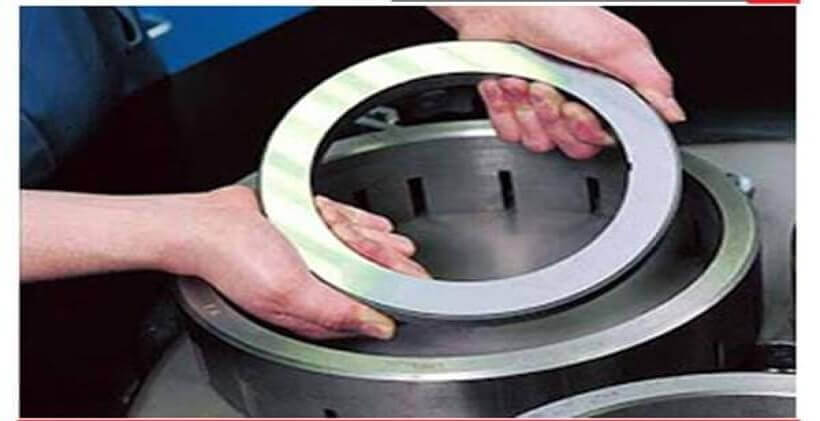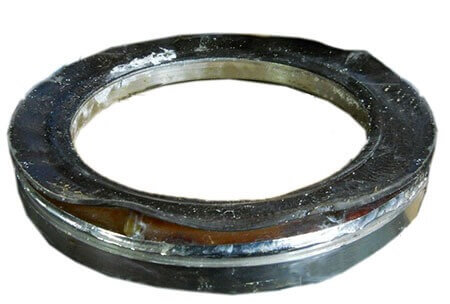Specialized troubleshooting and repairing mechanical seals:
Seal mechanical is often faced with dangerous, toxic and flammable fluids and must work under harsh conditions such as high speed, temperature and pressure; therefore, sealing wear is inevitable, especially in working conditions close to the highest limit for the system.
The choice of whether to repair or replace the seal is up to the technician and the user, and choosing repair over replacement to reduce costs is completely understandable.
repairing mechanical seal process is slightly different for different systems, but in general, after disassembling the parts, some of them are cleaned and others, such as elastomers and metal parts, are replaced.
The final result should be such that the performance is as good as a new system.
Heat damage:
The creation of radial cracks from the center of metal and ceramic rings is due to high heat. According to the opinion of Fluid Sealing Association (FSA), these cracks in sealing surfaces act like cutting edges, which will eventually cause sealing wear due to their abrasive properties.
This problem occurs in cases where a fluid with low density and high speed and pressure is used. The result of this process is fluid dripping regardless of whether the shaft is moving or stationary.
Factors affecting this problem are insufficient amount of fluid for lubrication, cooling less than the required amount and evaporation of fluid on the sealing surface.
As a precaution, make sure there is enough fluid on the sealing surfaces. Other measures that are taken to solve this problem include:
- Checking the pressure inside the chamber to ensure that the fluid does not evaporate
- Checking the sealing settings to ensure the correct height of the elements
- Checking the tolerances between the shaft and the main ring at the working temperature
- Checking the presence of distortion in the connecting rings
High wear and groove:
Groove wear usually occurs in connecting rings. The main rim has a 360 degree groove in the connecting rim. The sign to recognize this case is fluid dripping from the seal independent of the movement or stability of the shaft.
There are many factors that cause grooves. Poor lubrication, especially when the surfaces are hard, is one such factor. In rings that are made of soft materials, fluid corrosion will cause grooves.
To prevent leakage due to groove growth, do the following:
Increasing the amount of cooling in sealing surfaces
Checking the presence of corrosive particles in the fluid
Checking the presence of blockage in the sealing chamber
Freaking:
The coking process creates a black layer on the part that is under atmospheric pressure. This created layer causes severe wear of the sealing surfaces, which is usually done by oxidation.
Coking symptoms occur when the mechanical seal operates under high temperatures or in the presence of dirty fluid with solid particles.
Flushing the sealant from an external source or replacing the sealant surfaces with a hard type that resists oxidation can delay coking. Steam is used to clean the resulting layer.
Cavity and corrosion:
Chemical effects are one of the factors of corrosion and creating holes in mechanical seals. This usually happens when the wrong material is used for the sealing parts.
Corrosion also occurs as a result of the pump working without fluid. To prevent this damage, check the chemical compatibility of the fluid with the sealing surfaces, and when choosing parts, always consider normal working conditions without cleaning processes.
Burns of sealing surfaces:
This is a sign of heat damage and is recognized by the circular areas raised from the carbon surface of the seal. Burns are one of the common causes of sealing leaks; Because the burnt part increases the distance between the sealing elements.
The sealing surfaces must be very smooth and the presence of the smallest amount of contamination such as burns will cause leakage.
Burns are more common in pumps that are used frequently. Also, in the presence of fluid with high viscosity, the possibility of burns increases.
When the temperature of the sealing surfaces increases, the high-viscosity fluid in the cavities of the surfaces is quickly pushed out.
Improper cooling and fluid circulation on sealing surfaces also increase the possibility of burns. To reduce the risk of burns, reduce frequent switching on and off.
If possible, use impervious surfaces for repairing mechanical seal flooding to eliminate the possibility of corrosive fluid penetration.




